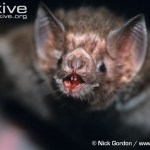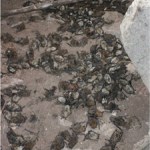bat
By U.S. Fish and Wildlife Service Headquarters [CC BY 2.0 (http://creativecommons.org/licenses/by/2.0) or Public domain], via Wikimedia Commons
Got bugs? Get a bat. As many species of bats are insectivores, they help keep insect populations in check. Hurricane Harvey has been devastating to people, animals and property. So it probably comes as no surprise that there are many volunteers dedicating their time to saving animals displaced by Hurricane Harvey as well. From squirrels, cats and dogs to...you guessed it...bats. It turns out that bats are not very…
Image source: Smithsonian Institution
You may recall prior Lifelines posts discussing the devastating effects of white nose syndrome (WNS) in bats. WNS, Pseudogymnoascus destructans is a fungus responsible for the deaths of millions of North American bats over the last ten years. In a new study published in the American Journal of Physiology - Regulatory, Integrative and Comparative Physiology, Dr. Craig Willis examined the effects of repeated arousals from hibernation induced by the fungal infection. Data from this new study provides evidence that infected animals do…
Image of big eared bats By Stihler Craig, U.S. Fish and Wildlife Service [Public domain], via Wikimedia Commons
According to a press release from Northern Arizona University, Drs. Faith Walker and Carol Chambers at the Bat Ecology & Genetics Lab have developed a system called Species From Feces to identify bat species from guano collected in field locations such as mines, caves, bridges, etc. The system takes advantage of DNA sequencing technology and an assay to look for genetic identifiers unique to different species using DNA barcodes. The sequences can then be…
With Halloween quickly approaching, I thought it would be fun to take some time to appreciate bats. Amazing animals!
Image of a corn earworm by Sarah from Statesboro GA, USA (Corn Earworm on corn ear) [CC BY 2.0 (http://creativecommons.org/licenses/by/2.0)], via Wikimedia Commons
New research published in the Proceedings of the National Academy of Sciences shows that bats are important nocturnal predators of insects that would otherwise attack crops. In addition, bats help to protect crops from fungal infections brought on by pests and are important pollinators. According to the new research, the pest-control services provided by bats for corn crops alone is worth about 1 billion…
Image of Gould's long-eared bat from http://www.wiresnr.org/Microbats.htmlImage by: Lib Ruytenberg
I came across a neat study published recently in the American Journal of Physiology - Regulatory, Integrative and Comparative Physiology which examined how bats arouse from hibernation, a period during which their body temperature and metabolism are low. To minimize the high energetic costs of warming up during arousal, bats use solar radiation or take advantage of fluctuations in the ambient temperatures (i.e. environmental).
Researchers studied hibernating long-eared bats (Nyctophilus…
Image of a big-eared bat from Scientific American
The New Guinea big-eared bat (Pharotis imogene; specimen pictured above) was thought to be extinct for the past 120 years. The bat is now considered critically endangered or possibly extinct as this specimen is the only known member of the genus. Since very little is known of this endangered bat, researchers who identified this specimen suggest that further research is needed to determine its abundance and distribution. With ongoing deforestation in New Guinea, this species may very well actually become extinct.
Source:
www.…
Check out this neat video highlighting how frog-eating bats are using frog mating calls to know where to pick up dinner:
Clip Art from www.LeeHanson.com
Just in time for Halloween:
Besides being an excellent way to avoid predators, roosting or hanging upside down is optimal for taking off into flight. Bats are not able to launch into flight from an upright position because their wings do not generate sufficient lift while at a dead stop. Additionally, their hindlegs are rather underdeveloped, so they are not able to run to generate lift for take-off. Instead, bats essentially fall into flight.
Learn more in this video comparing flight mechanics in bats and birds:
Source:
Animal Plant
A Cold War bunker at Loring Air Force Base in Maine that has been converted into a winter haven for bats. Image from: BBC News, USFWS/S. Agius
Scientists in Maine have converted two Cold War bunkers at Loring Air Force Base into winter havens for bats in an effort to protect the animals from the fungus that causes white nose syndrome. What is nice about using a man-made space is that they can actually clean up the area as opposed to trying to kill the fungus in a cave where multiple species of fungi may be affected, thereby disrupting the micro-ecosystem. The winter survival…
Carol Meteyer, USGS National Wildlife Health Center
With an estimated 6.7 million bat deaths related to white nose syndrome, understanding this devastating disease is more important than ever. Wildlife Pathologist Carol Meteyer, from the USGS National Wildlife Health Center, has been studying the carcasses of bats that survived white nose syndrome infections, only to succumb to their own immune systems. The overactive immune response is called immune reconstitution inflammatory syndrome (IRIS). While hibernating, the immune system of these bats are…
Researchers have discovered six people living in remote areas of Peru (Truenococha and Santa Marta) with natural antibodies against rabies despite never having received a vaccination for this deadly virus. They hypothesize that vampire bats actually transmitted small doses of the virus to people over time creating the natural antibodies. All six individuals reported having been exposed to the bats either through a bite or direct contact (scratch, touching).
While the levels of antibodies in the individuals were low, they might be enough to trigger an immune response…
Regular readers of this blog know that while I think studying animal cognition, behavior, and communication is (sometimes) fun and (always) interesting, the real importance - the why should I care about this - is because by understanding animals, we can attempt to learn more about ourselves.
I've written about this before. Here are the relevant excerpts:
When human adults show complex, possibly culture-specific skills, they emerge from a set of psychological (and thus neural) mechanisms which have two properties:
(1) they evolved early in the timecourse of evolution and are shared with other…
A Madagascar sucker-footed bat (Myzopoda aurita).
In the tropical forests of Madagascar, there lives a very peculiar kind of bat. While most bats roost by hanging upside-down from cave ceilings or tree branches, the Madagascar sucker-footed bat (Myzopoda aurita) holds itself head-up thanks to a set of adhesive pads on its wings. Nor is it the only bat to do so. Thousands of miles away in the jungles of Central and South America, Spix's disk-winged bat (Thyroptera tricolor) does the same thing, but how do their sucker pads work, and why do they choose to roost in a different way from all…
Following up on the previous white-nose syndrome blog, WNS has now been confirmed in Missouri. The article is about their monitoring program and does not mention the find, but our sources tell us there was recent PCR-confirmation of Geomyces destructans in samples taken from suspect bats in Missouri as part of this monitoring program.
One way you can help save our bats is to look into getting a bat house. Bat Conservation International and the Organization for Bat Conservation both have great information about bat houses, and here is a wonderful homeowner's guide to bats.
Bat houses are…
I hate to get all serious, but this is a topic near-and-dear to me, and one that needs more publicity. And while Zooillogix readers are intelligent and well-informed (and smoking hot, I might add), I want to be sure everyone is aware of the progress and potential of this epidemic. Plus, I know I'm not the only batfan here.
In February of 2006, a caver in eastern New York photographed a group of hibernating bats with an unusual white substance on their muzzles. The following winter, bats were noted flying outside of caves months before they typically come out of hibernation. Then there…
Not Exactly Pocket Science is a set of shorter write-ups on new stories with links to more detailed takes by the world's best journalists and bloggers. It is meant to complement the usual fare of detailed pieces that are typical for this blog.
Geneticist sequences own genome, finds genetic cause of his disease
If you've got an inherited disease and you want to find the genetic faults responsible, it certainly helps if you're a prominent geneticist. James Lupski (right) from the Baylor College of Medicine suffers from an incurable condition called Charcot-Marie-Tooth (CMT) disease, which…
It turns out I have more in common with my favorite animal than I thought. NOTE: Usually I find an article and then regurgitate it into the cheeping mouths of our readers in my own words. In this case, I kind of like how the article was written in the first place, so I'm just going to link to it..
Great pic.
Thanks to NVDH for uncovering this one.
P.S. Isn't it hilarious when you go to make a tag called "alcohol" for a piece on the blog, but that tag has already been created? Clearly we've covered this topic before.
Millions of years before humans invented sonar, bats and toothed whales had mastered the biological version of the same trick - echolocation. By timing the echoes of their calls, one group effortlessly flies through the darkest of skies and the other swims through the murkiest of waters. It's amazing enough that two such different groups of mammals should have evolved the same trick but that similarity isn't just skin deep.
The echolocation abilities of bats and whales, though different in their details, rely on the same changes to the same gene - Prestin. These changes have produced such…







